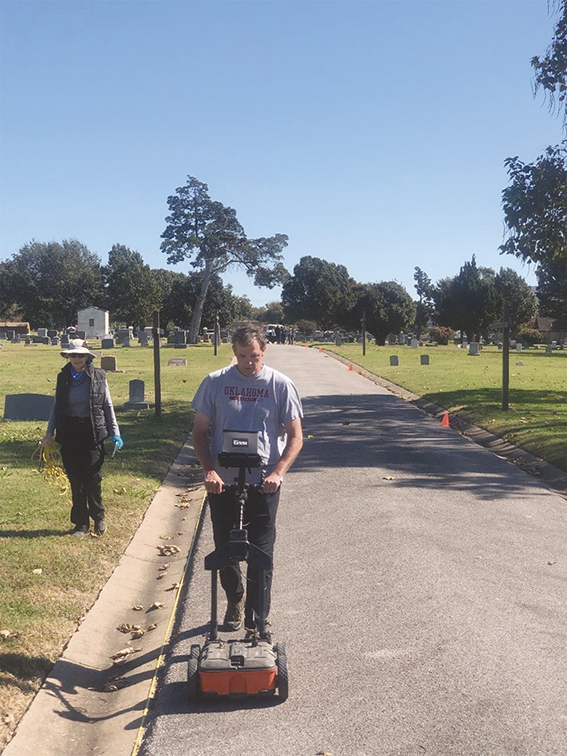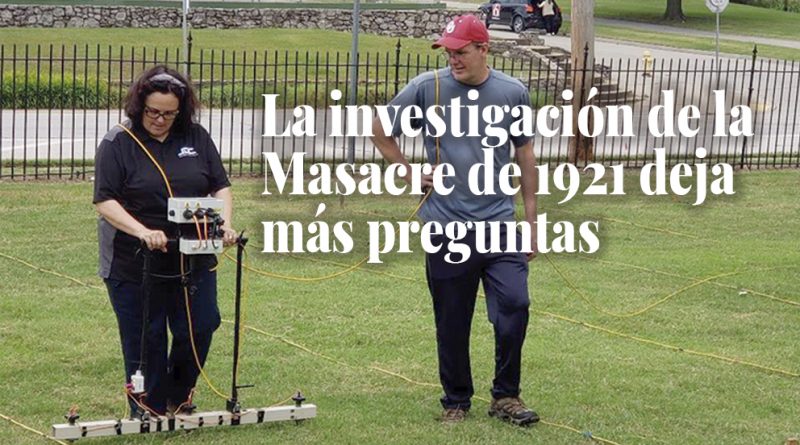1921 Race Massacre investigation leaves more questions
TULSA, OK – El comité de supervisión pública para la investigación de Graves acerca de la masacre racista de Tulsa en 1921 se reunió el lunes por la noche para escuchar al comité de investigación física, que incluye el estudio arqueológico de Oklahoma con sede en la universidad de Oklahoma, sobre el análisis del trabajo de campo del cementerio Oaklawn y el parquet Newblock en Tulsa. Los resultados del informe fueron mixtos.
“Del 7 al 11 y del 14 al 17 de octubre de 2019, a pedido de la ciudad de Tulsa, el estudio arqueológico de Oklahoma realizó un estudio geofísico de partes del cementerio Oaklawn, The Canes y Newblock Park para localizar posibles lugares de entierro asociados con la masacre racista de Tulsa en 1921 ”, afirma el informe. “No se encontraron anomalías consistentes con las tumbas en Newblock Park. Sin embargo, se identificaron posibles tumbas comunes en The Canes y el área de Sexton en el cementerio Oaklawn ”.
Esto significa que se necesitará más investigación para resolver un misterio mortal que ha manchado la ciudad de Tulsa durante casi cien años.
“Los hallazgos técnicos están, y los expertos del estudio arqueológico de Oklahoma han identificado una anomalía en el cementerio Oaklawn consistente con una ‘tumba común'”, dijo el alcalde de Tulsa G.T. Bynum después de que el informe inicial fue dado a conocer. “Todavía queda mucho trabajo por hacer para determinar si se trata de una fosa común de la masacre de Tulsa de 1921, pero seguiremos la verdad, dondequiera que lleve”.
Bynum ha prometido transparencia total en la investigación, que según él es dirigida adecuadamente por el público, porque la ciudad no cumplió con sus obligaciones durante tantos años.
“La triste realidad es que la mayor parte de un siglo pasó cuando la gente de Tulsa no quería hablar de esto en absoluto, donde la gente trabajó activamente para encubrirlo a principios del siglo XX, y casi lo logró, ”Dijo el alcalde. “Estamos en un punto en el que esta generación de tulsanos cree que las víctimas de este evento merecen que se conozca la verdad, y buscaremos eso incluso si revela cosas muy vergonzosas sobre la historia de la ciudad o la historia de nuestra comunidad”. Creemos que la verdad es más importante, tanto para las víctimas como para el futuro “.
El comité de supervisión pública se volverá a reunir el 3 de febrero a las 5:30 p.m. en el centro cultural Greenwood, 322 N. Greenwood Ave., para seguir desarrollando los próximos pasos de la investigación física. (Los reporteros de La Semana contribuyeron a este artículo)

1921 Race Massacre investigation leaves more questions
TULSA, OK – The Public Oversight Committee for the 1921 Tulsa Race Massacre Graves Investigation met Monday evening to hear from the physical investigation committee, which includes the Oklahoma Archeological Survey based at the University of Oklahoma, regarding the field work analysis from Oaklawn Cemetery and Newblock Park in Tulsa. The results of the report were mixed.
“From October 7-11 and 14-17, 2019, at the request of the City of Tulsa, the Oklahoma Archeological Survey conducted a geophysical survey of portions of Oaklawn Cemetery, The Canes, and Newblock Park to locate potential burial locations associated with the Tulsa Race Massacre of 1921,” the report states. “No anomalies consistent with graves were found at Newblock Park. However, possible common graves were identified at The Canes and the Sexton Area in Oaklawn Cemetery.”
This means more investigation will be needed to solve a deadly mystery that has stained the city of Tulsa for nearly a hundred years.
“The technical findings are in, and experts from the Oklahoma Archaeological Survey have identified an anomaly in Oaklawn Cemetery consistent with a ‘common grave,’” Tulsa Mayor G.T. Bynum said after the initial report was release. “There is still much work to be done to determine if this is a mass grave from the 1921 Tulsa Race Massacre, but we will continue to follow the truth – wherever it may lead.”

Bynum has vowed complete transparency in the investigation, which he said is appropriately led by the public, because the city failed to live up to its obligations for so many years.
“The sad reality is the better part of a century went by where the people of Tulsa didn’t want to talk about this at all, where people actively worked to cover it up in the early part of the 20th century, and almost succeeded,” the mayor said. “We’re at a point now where this generation of Tulsans believes that the victims of this event deserve the truth to come to light, and we will pursue that even if it reveals very disgraceful things about the city’s history, or our community’s history. We think the truth is more important, both for the victims and for the future.”
The Public Oversight Committee will reconvene on Feb. 3, 5:30 p.m. at Greenwood Cultural Center, 322 N. Greenwood Ave., to further develop next steps of the physical investigation. (La Semana reporters contributed to this article)


 (1) (2).jpg)


Debe estar conectado para enviar un comentario.